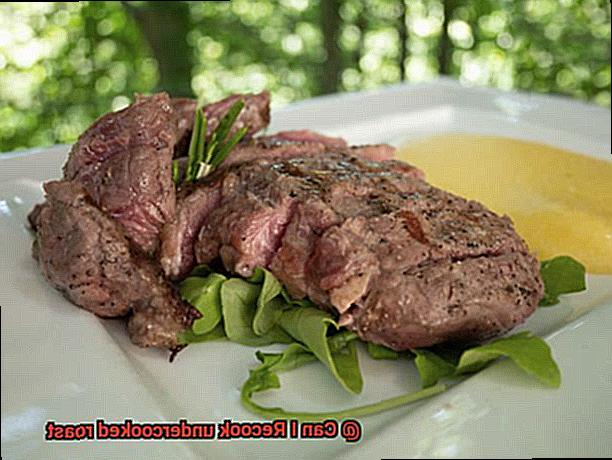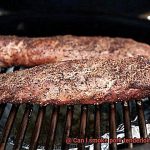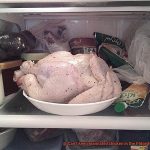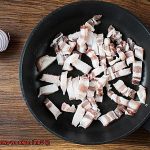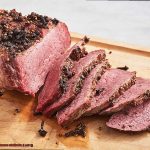Picture this: you’ve spent hours in the kitchen, carefully seasoning and roasting a beautiful cut of meat. You eagerly slice into it, only to find that it’s still undercooked. We’ve all been there – the disappointment can be crushing. But before you give up and order takeout, have you considered recooking your roast?
Yes, my friend, it is indeed possible to save an undercooked roast. But don’t go throwing it back in the oven just yet – there are some important things to consider first. What kind of meat are you dealing with? How was it cooked initially? And just how undercooked is it? Fear not, because with the right approach, you can turn your culinary mishap into a triumph.
In this blog post, we’re going to explore the art of recooking undercooked roast. We’ll start by discussing why roasts sometimes end up undercooked and what to do if it happens to you. Then we’ll dive into different methods for recooking your roast – from oven-roasting to slow-cooking – and share tips for success with each one. Finally, we’ll wrap things up with expert advice on how to ensure your next roast comes out perfectly cooked every time.
Whether you’re a novice cook or a seasoned pro, we’ve got you covered. So let’s roll up our sleeves and learn how to rescue that undercooked roast like a boss.
Contents
Assessing the Degree of Undercooked-ness
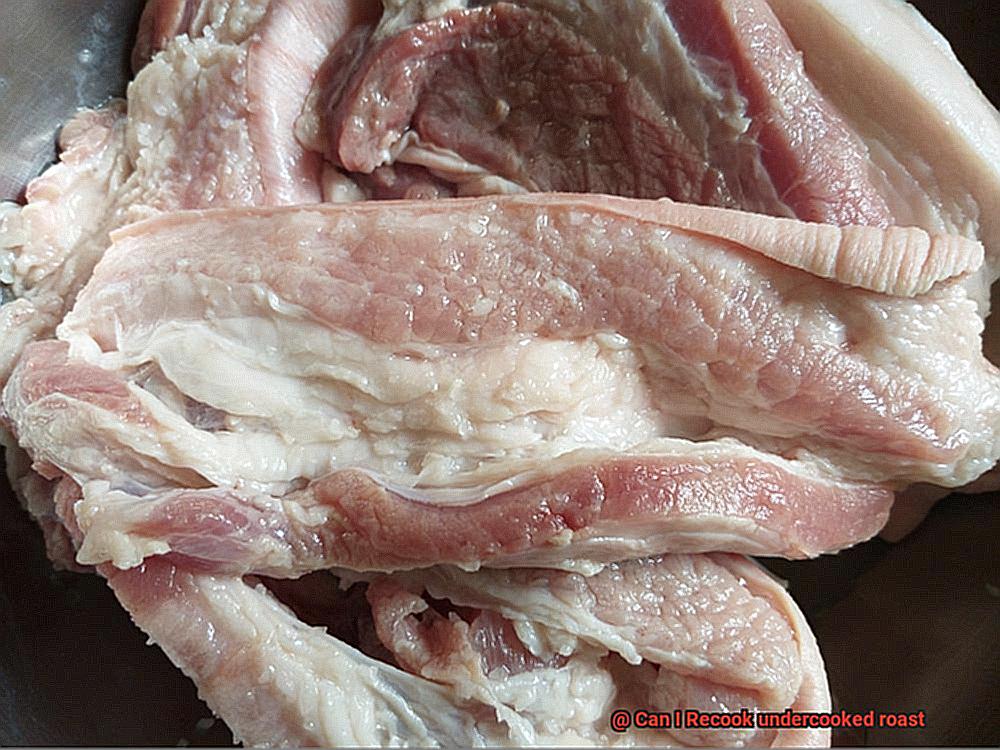
Cooking a roast can be a challenging task, and sometimes things do not go as expected. However, an undercooked roast is not lost yet, and with some critical considerations, it can still be saved. Assessing the degree of undercooked-ness is a crucial step in determining whether the roast needs to be recooked or not.
The first step in assessing the degree of undercooked-ness is to check the internal temperature of the meat using a meat thermometer. A roast that is undercooked will have an internal temperature below the recommended temperature for the desired level of doneness. For instance, a medium-rare roast should have an internal temperature of 135°F, while a medium roast should have an internal temperature of 145°F. If the internal temperature of the roast is below these temperatures, it is undercooked and requires additional cooking.
Another way to assess the degree of undercooked-ness is by examining the color and texture of the meat. Undercooked meat will appear pink or red in color and will be soft and squishy to the touch. In contrast, thoroughly cooked meat will be browned on the outside and firm to the touch.
If only a small area of the roast is undercooked, then it might be possible to save it by returning it to the oven for a brief period. However, if the roast is significantly undercooked throughout, it’s best to slice it into smaller pieces and recook them individually.
When deciding how to recook an undercooked roast, consider the initial cooking method used. If it was initially cooked in the oven, then it’s best to continue cooking it in the oven. If it was cooked on the stovetop or grill, then use the same method for reheating.
It’s also essential to ensure that the meat reaches a safe internal temperature. The USDA recommends a minimum internal temperature of 145°F for beef roasts, and 165°F for pork roasts. When recooking an undercooked roast, it’s vital to use a meat thermometer again to ensure that the meat reaches this safe internal temperature.
Reheating Method
It’s a delicate task that requires some knowledge to ensure the meat is cooked thoroughly without sacrificing its tenderness. But fear not, there are several methods available to you.
First up, we have the oven method. This is an excellent option if you want to reheat your roast quickly and evenly. Preheat your oven to 350°F and place your undercooked roast in a baking dish with some beef broth or water. Cover the dish with foil and cook for about 30 minutes per pound of meat, or until the internal temperature reaches 145°F. Remember to use a meat thermometer to check the temperature of the meat so that you can be sure it’s cooked properly.
If you don’t have access to an oven or want to save on energy costs, the stovetop method is ideal. Cut your undercooked roast into smaller pieces and place them in a saucepan with some beef broth or water. Cover the pan and cook on low heat for about 20 minutes, stirring occasionally, until the internal temperature reaches 145°F.
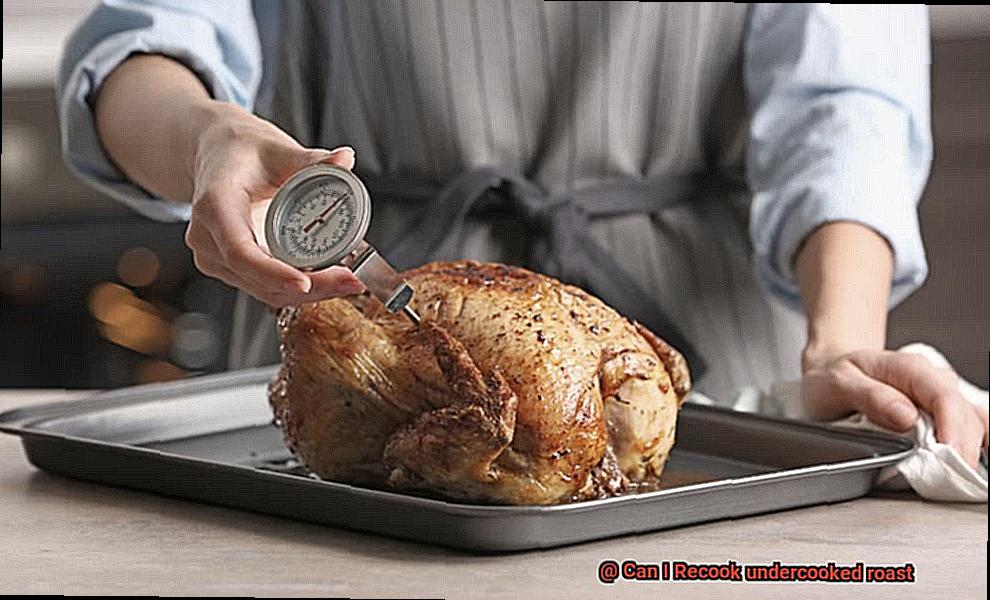
For those who want a tender and juicy roast, the slow cooker method is perfect. Place your undercooked roast in the slow cooker with some beef broth or water and cook on low heat for about 6-8 hours, or until the internal temperature reaches 145°F.
It’s crucial to note that using a microwave to reheat your undercooked roast is not recommended as it can dry out the meat and make it tough. Always check the internal temperature of the meat with a thermometer before consuming to ensure that it has reached a safe temperature.
Internal Temperature
It all comes down to monitoring the internal temperature. Yes, it may seem like a tedious task, but trust me, it’s worth it for the ultimate flavor and safety.
Let’s start with the basics. Internal temperature refers to the temperature inside the meat, not the oven or stovetop temperature. Each type of meat has a recommended internal temperature for safe consumption. For beef, the USDA suggests 145°F for medium-rare, 160°F for medium, and 170°F for well-done. Pork, on the other hand, requires an internal temperature of 145°F for all cuts of meat.
But why is monitoring internal temperature so important? Beyond ensuring that harmful bacteria are eliminated, it also affects the taste and tenderness of your roast. No one wants tough and dry meat.
If you find yourself with an undercooked roast, don’t panic. Use a meat thermometer to check the internal temperature by inserting it into the thickest part of the meat while avoiding bone or fat. If it hasn’t reached the recommended level yet, simply recook it until it does. But remember, overcooking can lead to tough and dry meat.
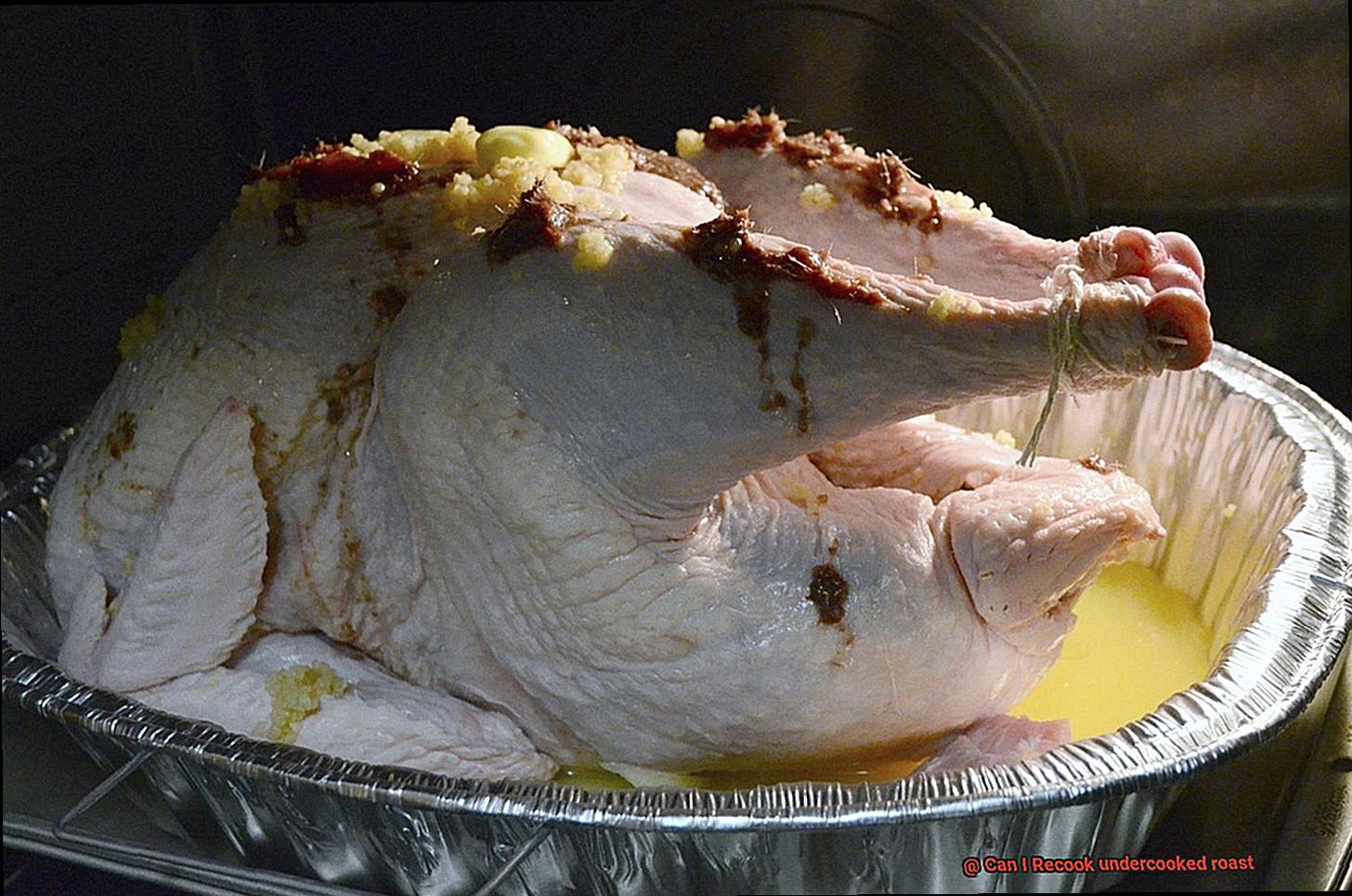
To avoid overcooking, monitor the temperature closely and avoid prolonged cooking at high temperatures. A lower temperature will allow the heat to distribute evenly without drying out your roast.
Simple Seasonings
Now, we’re going to tackle the age-old problem of undercooked roasts. We’ve all encountered it – you eagerly carve into your roast, only to find that it’s not cooked to perfection. But fret not. As a simple seasoning expert, I’m here to share some tips on how to transform an undercooked roast using basic ingredients from your pantry.
The key to seasoning an undercooked roast is simplicity. You don’t want to overpower the natural flavor of the meat; rather, you want to enhance it with just a few select seasonings. A classic combination of salt, pepper, and garlic powder works wonders for most types of meat. Generously sprinkle these three seasonings over your undercooked roast before popping it back into the oven. This trio will mask any undercooked taste while adding just enough flavor to make your taste buds dance.
For those feeling a little adventurous, a dry rub is an excellent option. A dry rub is a blend of spices and herbs rubbed onto the surface of the meat before cooking. For an undercooked roast, consider a simple blend of paprika, chili powder, cumin, and brown sugar. The sweet and spicy flavors in this combination help cover up any signs of undercooking while adding depth and complexity to the meat.
If you prefer a more traditional approach, rosemary and thyme are always a reliable choice. These two herbs complement each other well and are often used in pot roast dishes. They subtly add an earthy flavor that pairs perfectly with beef and enhances the natural flavors of the meat.
In summary, seasoning an undercooked roast is about balance and simplicity. Choose a few basic seasonings that complement the natural flavor of the meat without overpowering it. Here’s a quick recap of our simple seasoning options:
- Salt, pepper, and garlic powder
- Paprika, chili powder, cumin, and brown sugar dry rub
- Rosemary and thyme
Considerations for Recooking an Undercooked Roast
But rather than giving up on your meal, consider recooking it with some essential considerations in mind.
Firstly, proper storage is crucial before attempting to recook your roast. If the meat has been sitting at room temperature for over two hours, it may have entered the “danger zone” where bacteria can rapidly grow. In this case, it’s best to discard the meat to avoid potential foodborne illness.
Secondly, identifying the root cause of the undercooking is essential. Was it due to a low oven temperature or insufficient cooking time? Addressing these issues before recooking will save you from disappointment and ensure your roast comes out perfectly cooked.
It’s also crucial to consider the type of meat used for your roast. Certain cuts like pork and poultry can be harmful if not cooked thoroughly. It’s better to err on the side of caution and dispose of undercooked meat that falls into this category.
When you’re ready to recook your roast, use a food thermometer to ensure it reaches a safe internal temperature. The USDA recommends cooking beef roasts to 145°F and pork roasts to 160°F. This will guarantee that your meal is both delicious and safe to eat.
Tips for Cooking a Perfect Roast
Cooking a roast can be challenging, but with these tips, you can achieve a delicious and tender roast every time. Here are five tips to help you cook the perfect roast.
Choosing the Right Cut of Meat
The quality of meat is crucial when cooking a roast. Choose a cut with good marbling and fat content, such as ribeye or sirloin. These cuts will give your roast the flavor and tenderness that you desire.
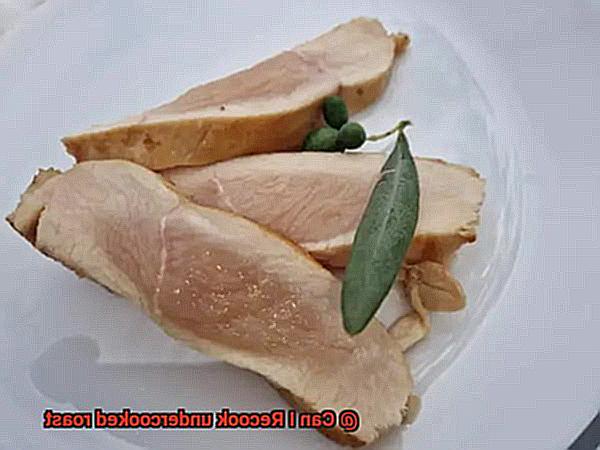
Preheating Your Oven
Preheat your oven to the desired temperature before placing your roast inside. This will ensure even cooking throughout the roast and prevent it from drying out.
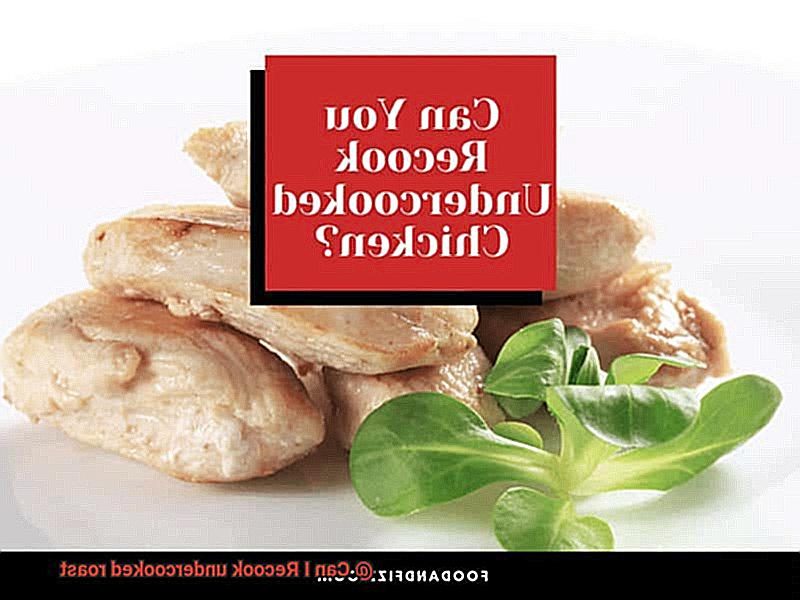
Using a Meat Thermometer
A meat thermometer is an essential tool for cooking the perfect roast. It helps you determine when the roast is done and prevents undercooking or overcooking. For a medium-rare roast, the internal temperature should be around 135°F, while a well-done roast should reach 160°F.
Letting the Roast Rest
After removing the roast from the oven, let it rest for 10-15 minutes before carving. This allows the juices to redistribute throughout the meat, resulting in a more tender and flavorful roast. If you cut into it too soon, all of the juices will escape, leaving you with a dry and tough roast.
Salvaging an Undercooked Roast
If you find that your roast is undercooked, don’t worry. You can still salvage it by returning it to the oven and cooking it for additional time until it reaches the desired internal temperature. However, be careful not to overcook it as this can result in a dry and tough roast.
The Benefits of Recooking an Undercooked Roast
Cooking a roast is a culinary masterpiece, but sometimes even seasoned chefs make mistakes. The frustration of pulling an undercooked roast out of the oven can be overwhelming, but don’t despair. With recooking, you can still salvage that meal and enjoy the many benefits that come with it.
Firstly, recooking your undercooked roast ensures that it’s cooked to a safe temperature. Undercooked meat can contain harmful bacteria such as salmonella or E.coli, which can cause food poisoning if consumed. By recooking the meat, you eliminate any harmful bacteria and make your meal safe to eat. Safety should always come first.
Secondly, recooking allows you to achieve your desired level of doneness. If you prefer your roast well-done but took it out too early, popping it back in the oven will help you achieve the desired level of doneness without overcooking it. The result is a perfectly cooked roast that’s sure to impress.
Lastly, recooking your undercooked roast can improve its texture and flavor. An improperly cooked roast can be tough and chewy, but by recooking it, you allow the meat to cook more evenly and tenderize properly. The result is a mouthwatering roast that’s both flavorful and tender.
Common Mistakes to Avoid When Recooking a Roast
By avoiding common mistakes and implementing some expert tips, you can turn that tough piece of meat into a succulent masterpiece.
First and foremost, proper seasoning is key. Don’t hold back on the herbs and spices. Season the meat generously to add flavor and cover up any dryness or toughness from the initial cooking process.
Next up, resting is crucial. Letting the roast rest for at least 10-15 minutes before carving allows the juices to redistribute throughout the meat, resulting in a more tender and flavorful final product. Don’t ruin your hard work by carving too soon and losing those precious juices.
Overcooking is another common mistake when recooking a roast. Keep a close eye on that internal temperature and remove the roast from the oven as soon as it reaches your desired level of doneness. Overcooked meat is dry and tough, making for an unpleasant eating experience.
Finally, invest in a good quality meat thermometer. This essential tool will help ensure that your roast is cooked to perfection and safe to eat every time.
LqcP56tsQEo” >
Conclusion
In conclusion, don’t let an undercooked roast ruin your meal. With the right approach and considerations, you can turn it into a triumph. The key is to assess the degree of undercooked-ness before deciding whether or not to recook your roast. Checking the internal temperature, color, and texture of the meat are all important factors.
Luckily, there are several viable options for reheating your undercooked roast such as oven-roasting, stovetop cooking, and slow-cooking. Just be sure to use a meat thermometer to ensure that the meat reaches a safe internal temperature. When it comes to seasoning an undercooked roast, simplicity is key with basic herbs and spices like salt, pepper, garlic powder, rosemary, thyme, or paprika.
Of course, prevention is always better than cure. When cooking a perfect roast from scratch, choosing the right cut of meat and preheating your oven at the desired temperature are crucial steps. Using a meat thermometer will help you determine when the roast is done while letting it rest for 10-15 minutes after removing from the oven will allow juices to redistribute throughout the meat.
Recooking an undercooked roast ensures that it’s cooked at a safe temperature while achieving desired level of doneness with improved texture and flavor. However, common mistakes like improper seasoning or overcooking should be avoided by investing in a good quality meat thermometer.

